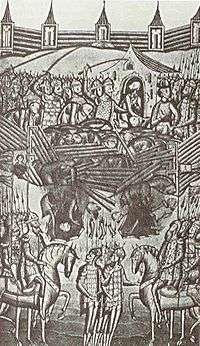Siege of Kiev (1240)
| Siege of Kiev | |||||||
|---|---|---|---|---|---|---|---|
| Part of Mongol invasion of Rus' | |||||||
 Occupation of Kiev in 1240. Illustration of a Russian annal | |||||||
| |||||||
| Belligerents | |||||||
| Mongol Empire |
| ||||||
| Commanders and leaders | |||||||
| Batu Khan | Voivode Dmytro | ||||||
| Strength | |||||||
| Unknown; probably large | ~1000 | ||||||
| Casualties and losses | |||||||
| Unknown; not very heavy | ~48 000 (including noncombatants) killed | ||||||
The Siege of Kiev by the Mongols took place between November 28 and December 6, 1240, and resulted in a Mongol victory. It was a heavy moral and military blow to Halych-Volhynia and allowed Batu Khan to proceed westward into Europe.[1]
Background
In 1237, the Mongols began their invasion of Rus by conquering the northern principalities of Ryazan and Vladimir-Suzdal. In 1239, they advanced against southern Rus, capturing the cities of Pereyaslav and Chernihiv.
When the Mongols sent several envoys to demand the city's submission, they were executed by Michael of Chernigov and later Dmytro.[2][3]
The next year, the Mongol general Batu Khan reached Kiev. At the time, the city was ruled by the principality of Halych-Volhynia. The chief commander in Kiev was Voivode Dmytro, while Danylo of Halych was in Hungary at that time, seeking a military union to prevent invasion. The number of defenders inside the city was only about 1,000.
The Siege
The vanguard army under Batu's cousin Möngke came near the city. Möngke was apparently taken by the splendor of Kiev and offered the city terms for surrender, but his envoys were killed.[4] The Mongols chose to assault the city. Batu Khan destroyed the forces of the Rus vassals, the Chorni Klobuky,[5] who were on their way to relieve Kiev, and the entire Mongol army camped outside the city gates, joining Möngke's troops.
On November 28 the Mongols set up catapults near Kiev's Lech gates (today - vicinity of Maidan Nezalezhnosti), one of the three gates of old Kiev and where tree cover extended almost to the city walls The Mongols then began a bombardment that lasted several days. On December 6, Kiev's walls were breached, and hand-to-hand combat followed in the streets. The Kievans suffered heavy losses and Dmytro was wounded by an arrow.
When night fell the Mongols held their positions while the Kievans retreated to the central parts of the city. Many people crowded into the Church of the Tithes. The next day, as the Mongols commenced the final assault, the church's balcony collapsed under the weight of the people standing on it, crushing many. After the Mongols won the battle, they plundered Kiev. Most of the population was massacred. Out of 50,000 inhabitants before the invasion, about 2,000 survived. Most of the city was burned and only six out of forty major buildings remained standing. Dmytro, however, was shown mercy for his bravery.
After their victory at Kiev, the Mongols were free to advance into Halych-Volhynia and Poland.
References
- ↑ Janet Martin Medieval Russia, 980-1584, p.139
- ↑ The Mongols by Stephen Turnbull, p.81
- ↑ Genghis Khan and the Mongol Empire by Jean Paul Roux, p.131
- ↑ Charles Halperin - The Tatar Yoke, p.43
- ↑ V. Minorksy - The Alān Capital *Magas and the Mongol Campaigns, Bulletin of the School of Oriental and African Studies, University of London, Vol. 14,No. 2 (1952), pp. 221-238
External links
- (Ukrainian) Rutheian chronicle (years 1224-1244), based on Hypatian Codex. (interpreted by Leonid Makhnovets)